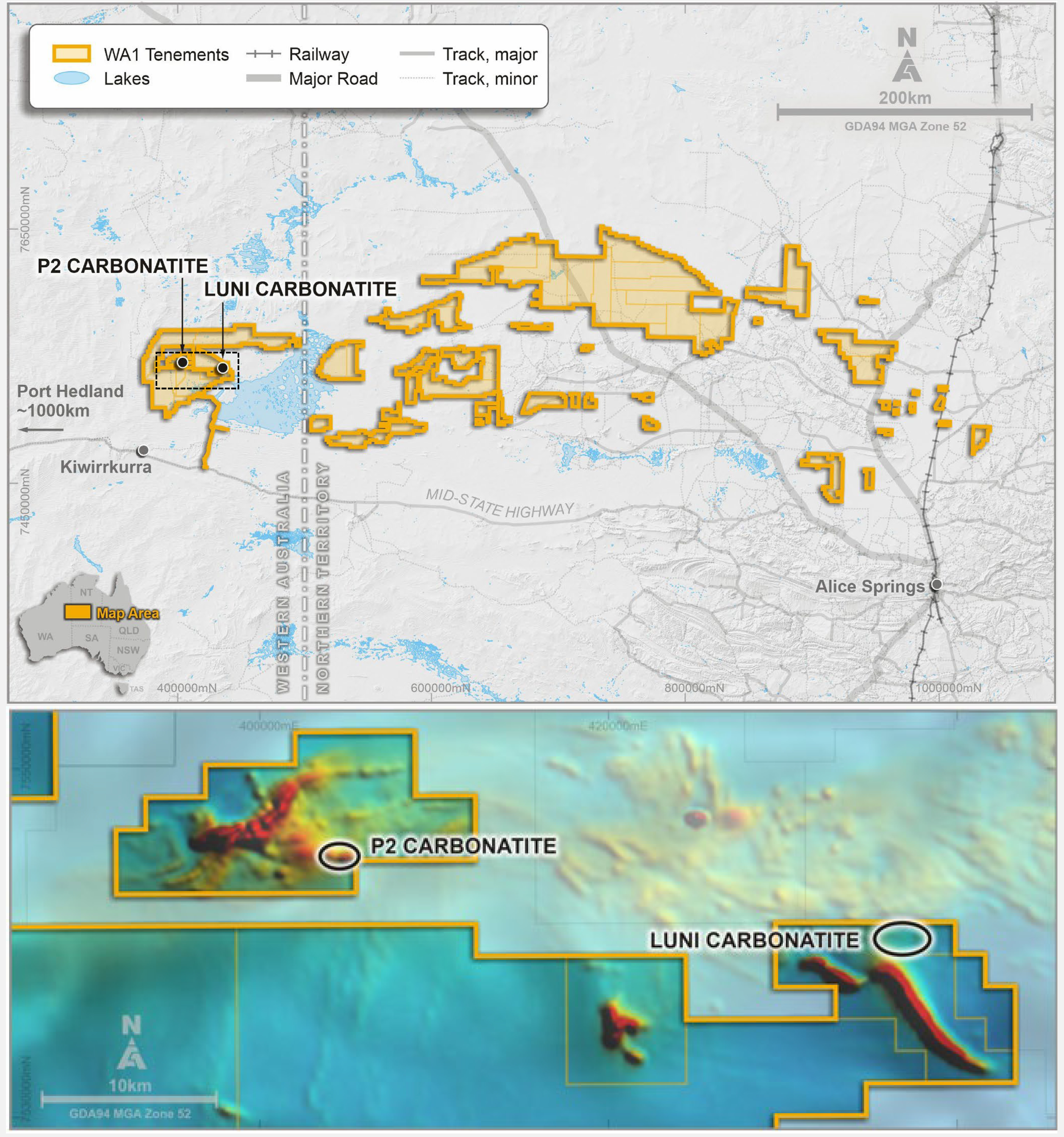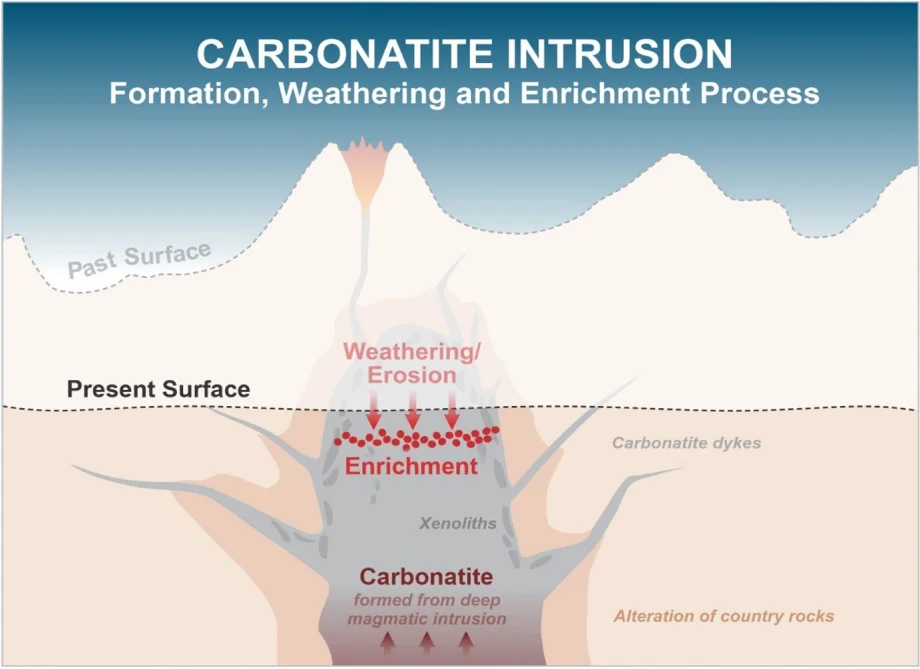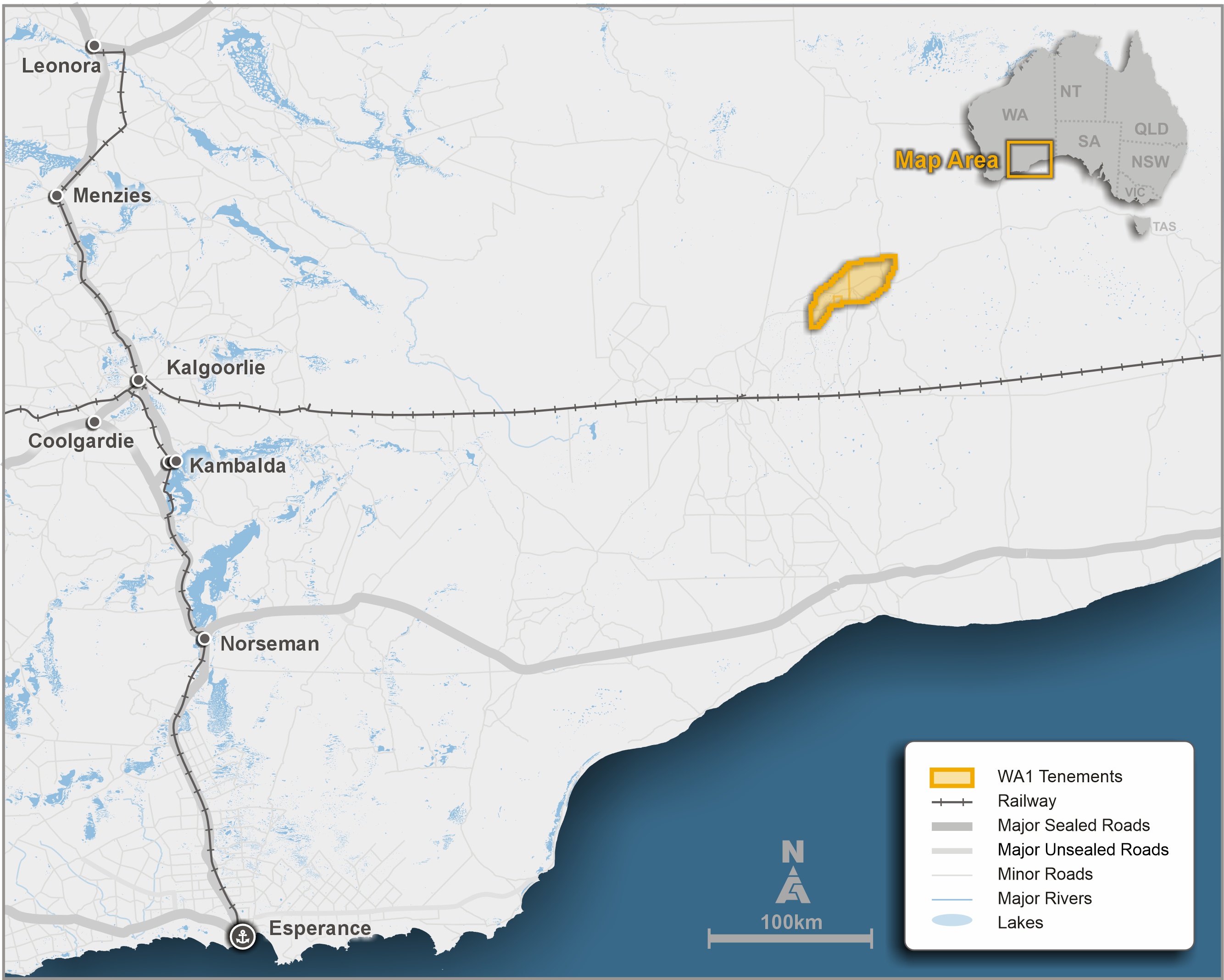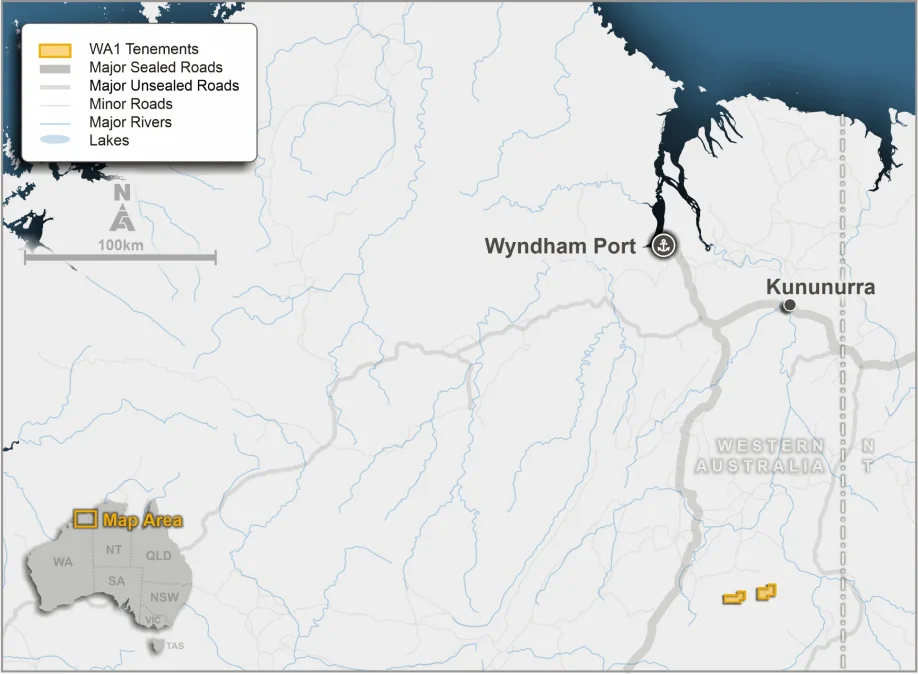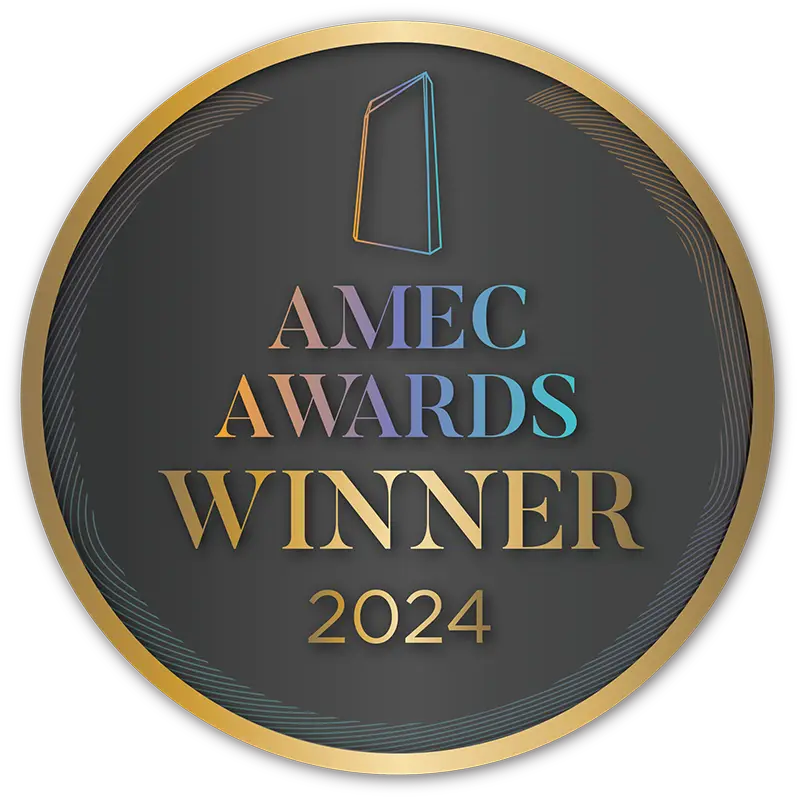Projects
EXPLORING NEW FRONTIERS
WA1 is an exploration and development company focused on future-facing minerals, anchored by its award-winning Luni Niobium Project in Western Australia and supported by a highly prospective tenure package across Australia’s underexplored regions.

WEST ARUNTA
The West Arunta Project is located approximately 490km south of Halls Creek in Western Australia. It comprises the Sambhar (containing the Luni carbonatite), Pachpadra (containing the P2 carbonatite) and Urmia prospects, all of which host large gravity (+/– magnetic) anomalies. A carbonatite is an igneous rock formed from a deep, mantle-derived magmatic intrusion. They are defined by their composition, being rich in carbonate minerals and often occurring as plugs within intrusive complexes, or as dykes, sills, breccias or veins. They may be mineralised with niobium, rare earth elements, phosphorus, tantalum and titanium, among other elements.
LUNI Niobium Project
Luni was discovered in November 2022 in the Company’s first drill program in the West Arunta. Luni is part of the Sambhar prospect area and is characterised by a discrete, high amplitude gravity anomaly with a limited but coincident magnetic response. It is also located at the intersection of two key interpreted regional structural features.
Initial drilling at Luni returned highly anomalous niobium, REE and phosphorous mineralisation in three holes up to 1.3km apart. The Luni geophysical anomaly covers an area of approximately 3km x 1km and since the discovery, step-out drilling has been completed on a pattern grid to define the extent of the mineralised system.
This step-out drilling supported the release of the initial Mineral Resource estimate (MRE) in July 2024, labelling Luni as the most significant niobium discovery in more than 70 years. In 2024 an intensive drilling campaign was strategically focused on advancing two key high-grade zones of the deposit, supporting the release of an updated MRE in July 2025. Since the initial MRE, 46% of Luni’s contained niobium has been upgraded to Indicated classification from within the two key high-grade zones (eastern and western), providing a strong basis for development studies and potential future operating flexibility.
Drilling to date has shown a shallow blanket of high-grade niobium mineralisation exists over a significant extent. This enriched layer is yet to be laterally constrained. The enriched layer often exists within part of a broader mineralised zone with more moderate average grade. Grades returned in drilling compare favourably with the resource grade of the world’s operating niobium mines.
Preliminary mineralogy and metallurgical testwork has been undertaken at Luni in advance of more detailed testwork using core samples. The preliminary work indicates the primary niobium bearing minerals are pyrochlore and columbite. Initial excellent flotation results demonstrated a high-grade niobium concentrate with low impurities and industry comparable recovery rates.
Further key workstreams supporting a future development have been initiated including water, environment, power, transport studies and niobium marketing are underway.
Mineral Resource EstimatE
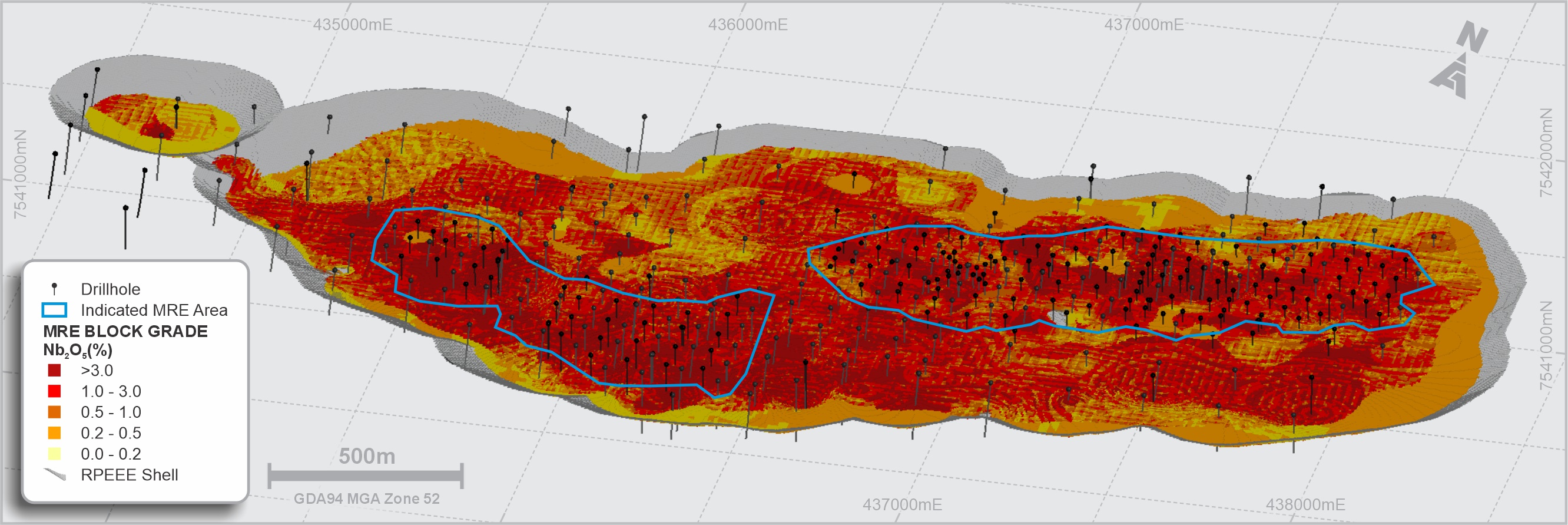
| Tonnes (Mt) | Nb2O5 (%) | Nb2O5 (kt) | P2O5 (%) | P2O5 (kt) | |
|---|---|---|---|---|---|
| Indicated | 73 | 1.38 | 1,000 | 11.3 | 8,200 |
| Inferred | 150 | 0.8 | 1,200 | 9.9 | 15,000 |
| Total | 220 | 1.0 | 2,200 | 10.3 | 23,000 |

- Mineral Resources are classified and reported in accordance with JORC Code (2012).
- The effective date of the Mineral Resource estimate is 30 June 2025.
- Part of the Mineral Resource that would potentially be extractable by open pit techniques is the portion of the block model that is constrained within an FeNb price of ~US$30/kg (contained Nb in FeNb payable at a price of US$45/kg) optimised pit shell and above a 0.25% Nb₂O₅ cut-off grade.
- Estimates are rounded to reflect the level of confidence in the Mineral Resources at the time of reporting.
- Rounding may cause computational discrepancies.
- The Mineral Resources (and RPEEE shell that constrained the MRE) are reported within the WA1 licence boundaries.
P2 CARBONATITE
P2 was the first carbonatite discovery we made in the West Arunta during drilling in October 2022. The P2 target area is characterised by a large gravity anomaly and semi-coincident magnetic anomaly which covers an area of approximately 2.5km x 1.0km.
Similar to the initial drilling at Luni, anomalous niobium, REE and phosphorous was encountered over large widths.
A ground-based gravity survey was completed in late 2022, followed by a ground-based passive seismic survey, to further refine drill targets. A reconnaissance drill program was then completed and confirmed a significant intrusive system of the scale of the originally interpreted geophysical anomaly.
Further RC drilling was completed at P2 in 2023, confirming the potential for a large mineralised carbonatite system. The P2 target may represent a future satellite opportunity for any potential development at Luni, located 30km west of P2.
OTHER TARGETS
WA1 is an exploration company with a focus on future facing commodities, with two projects located in Western Australia and the Northern Territory.
Several other geophysical targets have been identified in the Arunta region, the majority of which have not been subject to any previous drill testing.
Outside of Luni and P2, the only target which has been drill tested within the project area is the P1 which is located 7km northwest of P2. P1 presents as a regionally significant magnetic anomaly that extends in strike for over 12km and within a folded sequence of metasediments containing multiple interpreted gravity anomalies. Three holes were completed at P1 over a length of 600m and did not test the gravity anomalies within the system. The drilling intersected quartz-rich metasediments of sandstone protolith, a high iron magnetite rich unit and a paragneiss unit consisting of quartz, garnet and sillimanite metamorphosed to amphibolite grade. Low level niobium, REE and copper was reported. Further work at P1 is required.
For further information and the latest updates on our West Arunta activities, please refer to our recent ASX Announcements.
HIDDEN VALLEY
The Hidden Valley Project comprises one Exploration Licence application for 220km2 located 150km south of Kununurra, Western Australia. The tenement is geologically located within the Osmond Ranges, with work completed by previous explorers covering geophysical and surface geochemical surveys, geological mapping, and prospecting. While several anomalous indicators for gold and copper have been identified, no drilling has been undertaken.
The tenement lies within the Osmond Ranges and on a major structural position straddling the Osmond Fault. The fault is a unique east-north-east trending structural domain immediately east of the Halls Creek Orogen and along strike from IGO Ltd’s Osmond Valley Project.
No work has been completed in the tenement area since 2007, at which time airborne GEOTEM data collected by BHP in 1996 was reanalysed. This work concluded that the key anomalies in the region, known as the Osmond Pipes, are “wide conductive targets within an extensive zone (possibly middle Proterozoic rocks)” and were recommended for “further evaluation by way of additional electromagnetic (EM) surveys” (refer to WAMEX Report A78887 by Osmond Range Resources Pty Ltd for full details). In addition, these anomalies, which sit at the intersection of the Osmond Fault and Argyle Corridor, were concluded to be of potential ultramafic source.
While several anomalous indicators of Nickel, Copper and Gold mineralisation have been identified through earlier broad geochemical surveys in the region, no modern gravity or EM surveys have been completed and no drilling has been undertaken.
Accordingly, the adoption of EM geophysical techniques will assist with rapidly evaluating the Nickel-Copper intrusion model, as well the sediment hosted massive sulphide Lead-Zinc-Silver or Kimberlite pipe model for which potential also exists.

